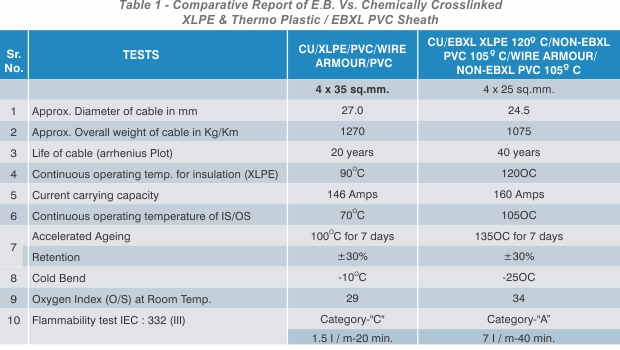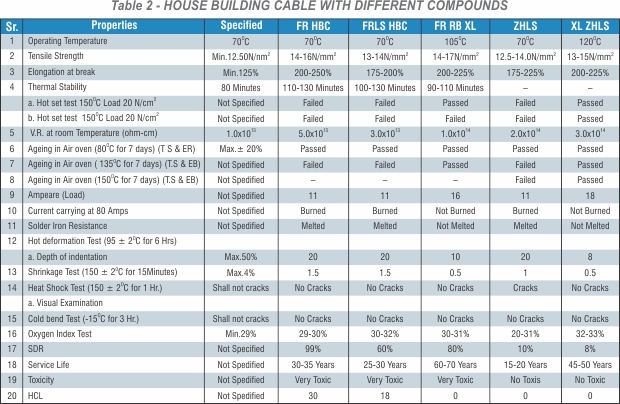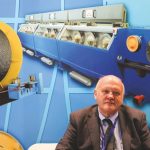Dr. V. K. Tikku, NEESON (Technical Consultant)
Introduction
The industrial applications of radiation processing in polymers, utilizing electron beam cross-linking, for modification and enhancement of polymeric properties has been well established over the past 80 years. Modification in polymeric structure of materials can be brought about either by conventional chemical means, usually involving silane or per-oxide or by exposure to ionizing radiation from energetic electrons from electron accelerators. The electron beam processing in wires and cables helps to improve thermal, chemical, barrier, impact wear and other mechanical properties to meet the demanding applications of the customers in wires and cables. This is evident from the large number (>2500) of EB machines presently working in India and abroad.
The growth of EB technology in last two decades in China and other countries including India establishes the process of cross-linking in wires and cables with the advantages of increased life, higher temperature withstand capability, higher current carrying capacity, improved physical properties with reduced thicknesses in these cables. Because of being superior in life and performance compared to conventional cables, cross-linked cables have already been adopted in all critical applications such as railways, defense, solar power, wind energy and nuclear power. Even PVC being used in building wires and power cables can be cross-linked with EB technology only. The EB cross-linking technology in PVC building wires and power cables not only increases life and the current carrying capacity to more than double, but also prevents fires due to overload short circuits and thus saves precious lives and property.
Electron Accelerator (EB) Facility
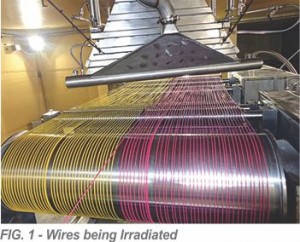 The manufacture of the new generation, EB cross-linked cables requires special polymeric compounds, its extrusion on to the cable and EB irradiation cross-linking. To cross-link these specialty power cables requires an accelerator of variable energy 1 to 3 MeV with power of 100 KW. The suitable handling systems are an essential requirement to uniform cross-link cables from small size 0.5 sq mm to 500 sq mm having max diameter up to 60 mm with sector shaped or circular conductors. Fig. 1 shows typically the layout of EB machine with suitable handling systems, irradiating small size wires.
The manufacture of the new generation, EB cross-linked cables requires special polymeric compounds, its extrusion on to the cable and EB irradiation cross-linking. To cross-link these specialty power cables requires an accelerator of variable energy 1 to 3 MeV with power of 100 KW. The suitable handling systems are an essential requirement to uniform cross-link cables from small size 0.5 sq mm to 500 sq mm having max diameter up to 60 mm with sector shaped or circular conductors. Fig. 1 shows typically the layout of EB machine with suitable handling systems, irradiating small size wires.
Specialty Power Cables
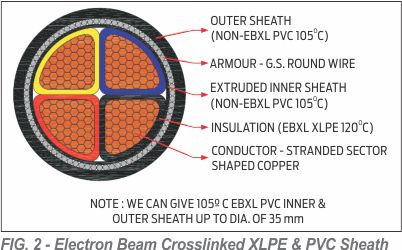 Fig.2 gives the cross-sectional area drawing of specialty power cables cross-linked with EB irradiation. The conductor is stranded sector shaped and is insulated with specially modified polyethylene base insulation. The insulation (XLPE) is cross-linked with EB irradiation and is suitable for continuous operation at 120°C. The inner and outer sheaths are specially formulated PVC suitable for 105°C, which can be cross-linked using e-beam up to a diameter of 35mm. The cable can be armored or unarmored. The EB cross-linking helps in improving the life of these power cables besides increasing the continuous current carrying capacity to 105°C of conductor temperature. Table 1 summarizes the technical characteristics of these e-beam cross-linked XLPE insulated vs. conventional chemical cross-linked XLPE insulated cables. The current rating for 105°C continuous operation of conductor temperature has been deduced from National Electricity code, USA, table 310.71, 310.73 & 310.75. The advantages of e-beam cross-linked XLPE is evident from increased life (double), temperature rating 120°C vs. 90°C, current carrying capacity about 11 percent more in spite of reducing conductor size smaller by one size. In addition, it withstands the stringent flammability test to IEC 332 (III) Category A compared to category C being met by chemically cross-linked XLPE insulated cable.
Fig.2 gives the cross-sectional area drawing of specialty power cables cross-linked with EB irradiation. The conductor is stranded sector shaped and is insulated with specially modified polyethylene base insulation. The insulation (XLPE) is cross-linked with EB irradiation and is suitable for continuous operation at 120°C. The inner and outer sheaths are specially formulated PVC suitable for 105°C, which can be cross-linked using e-beam up to a diameter of 35mm. The cable can be armored or unarmored. The EB cross-linking helps in improving the life of these power cables besides increasing the continuous current carrying capacity to 105°C of conductor temperature. Table 1 summarizes the technical characteristics of these e-beam cross-linked XLPE insulated vs. conventional chemical cross-linked XLPE insulated cables. The current rating for 105°C continuous operation of conductor temperature has been deduced from National Electricity code, USA, table 310.71, 310.73 & 310.75. The advantages of e-beam cross-linked XLPE is evident from increased life (double), temperature rating 120°C vs. 90°C, current carrying capacity about 11 percent more in spite of reducing conductor size smaller by one size. In addition, it withstands the stringent flammability test to IEC 332 (III) Category A compared to category C being met by chemically cross-linked XLPE insulated cable.
Cross-linked Building Wires & Flexibles
Table 2 summarizes the various types of building wires being manufactured in India and gives the comparison of its technical properties. The wires are FR HBC (flame retardant house building wires), FRLS HBC (flame retardant low-smoke and low-halogen), FR EBXL (flame retardant but e-beam cross-linked PVC), ZHLS (zero-halogen low-smoke) and XL ZHLS (EB cross-linked zero-halogen and low-smoke). The superiority of EB cross-linked PVC building wire over normal PVC building wire is evident with regards to superior electrical (volume resistivity), 50 percent more current carrying capacity in same size wire (1 sq.mm 16 A in place of 11 A), improved life (double) as it passes again at much higher temperature, i.e. 135°C instead of 80°C for normal PVC wires. In addition, it gives excellent resistance to the flammability and emits reduced smoke and acid compared to normal PVC wires. Most of the fires in buildings originate due to overloading, leading to overheating and thus melting the PVC insulation. Once wire becomes bare, it may short circuit between the wires or with 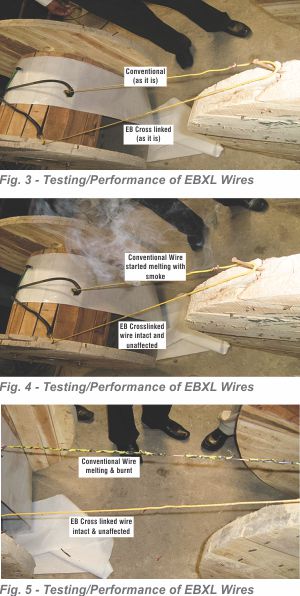 ground and may catch fire and propagate all along the cables spreading the fire. The EBXL HBC is the only wire which prevents this overload short-circuiting fire as it does not melt being cross-linked.
ground and may catch fire and propagate all along the cables spreading the fire. The EBXL HBC is the only wire which prevents this overload short-circuiting fire as it does not melt being cross-linked.
Fig.3 to 5 Shows the behavior of normal PVC Buildings wire, viz. EBXL HBC under overload condition.
Normal wire (conventional) and EB cross-linked PVC wires are connected in series and are connected to a current loading transformer (fig.3).
As we start increasing the current, within one minute, the normal wire starts smoking and melting (fig.4), whereas EBXL wires remains unaffected.
Within two minutes, after stopping the flow of current, one can see the condition of normal PVC building wire, which gets completely melted and burnt with conductor becoming naked (Fig.5) whereas the EBXL PVC (APAR ANUSHAKTI) remains unaffected.
Conclusion
Thus, it is technically evident from above that to meet today’s demanding requirements of higher performance standard of cables e-beam cross-linking is an essential technological process. That’s why the Indian cable industry has successfully adopted the state of the art electron beam irradiation cross-linking technology to meet the direct and indirect needs of our customers and achieve their complete satisfaction.



